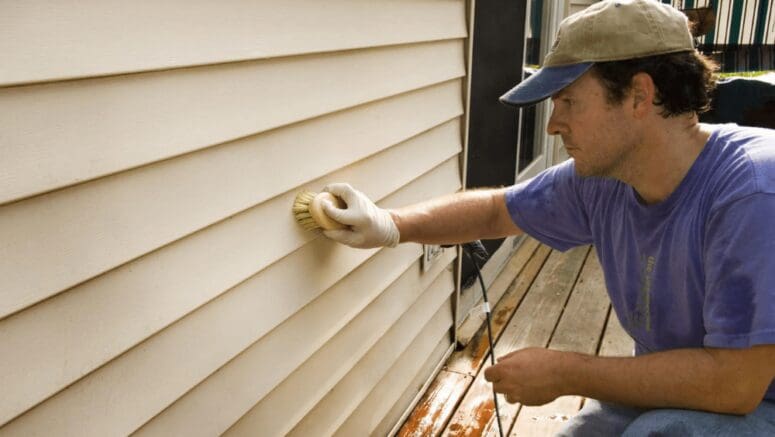Home Maintenance Checklist: Seasonal and Monthly To-Dos
- Published on
- 15 minute read
-
 Evette Zalvino, Contributing AuthorClose
Evette Zalvino, Contributing AuthorClose Evette Zalvino Contributing Author
Evette Zalvino Contributing AuthorEvette is just your average HGTV fan who dreams of having a home worthy of being on one of those shows. When she isn't writing for HomeLight, she's working at her local real estate office. In her downtime, you'll find her searching for the next great hiking trail in her area.
-
 Sam Dadofalza, Associate EditorClose
Sam Dadofalza, Associate EditorClose Sam Dadofalza Associate Editor
Sam Dadofalza Associate EditorSam Dadofalza is an associate editor at HomeLight, where she crafts insightful stories to guide homebuyers and sellers through the intricacies of real estate transactions. She has previously contributed to digital marketing firms and online business publications, honing her skills in creating engaging and informative content.
Let’s face it, being a homeowner is expensive. Figures on maintenance costs vary, but one quick rule advises homeowners to budget 1% of their home value in annual upkeep costs when tackling a home maintenance checklist. That means that with the median home price in the second quarter of 2024 reaching just over $400,000, owners should expect about $4,000 in annual maintenance costs.
Although you’re pouring money into the property, you won’t see the value of your home increase simply because you replaced the air filters or cleaned out the rain gutters. But, if you aren’t maintaining your home as you should, you could see the value of your home decrease when you decide to sell.
Note: You can get an idea of what your home’s value is, whether it needs minimal or significant maintenance, by using HomeLight’s Home Value Estimator. If your estimate is lower than you anticipated, following this home maintenance checklist is a great start to increasing your home’s value.
Julie Wyss, one of San Jose’s top 1% of real estate agents, shared an instance where she had two similar listings, one that was well-maintained (albeit not updated) and another that was not. The first listing sold above the asking price within five days. The second home sat on the market for several months and was only sold after several price reductions.
“Buyers do appreciate when a home has been maintained,” Wyss points out. If the functional features (water heater, furnace, roof, windows, and plumbing) of the house are well-maintained, the outdated countertops and vinyl flooring can be overlooked.
Home maintenance checklist: Where to begin?
Sometimes, it can be hard to decide where to start making repairs, especially if you’re planning to sell within the next year or two. While that sounds like a long way away, and you have plenty of time to get started, if you set aside a little time throughout the year to tackle these simple tasks, you’ll see that it’s worth the effort. Not just while you’re living in the house, but when you put it up for sale, too!
Are you ready to get started? We’ve organized our home maintenance schedule and checklist so you know how often a task should be done and the right time of year to do it.
Monthly maintenance tasks
The following maintenance tasks should be done each month, regardless of the season. They’re quick to do, but they’re also easy to forget.
Clean and replace HVAC filters
Replacing the air filters on your HVAC system can extend the life of your unit, improve air quality throughout the home, and make the unit work more efficiently.
Pro tip: An air filter subscription service like Second Nature is great for those who forget to change the filters on time.
Check the water softener
Hard water is horrible for your pipes and appliances and makes cleaning difficult due to mineral buildup. Look inside your brine tank once a month to make sure it’s half full. Refill if needed.
Clean and descale faucets and shower heads
Over time, your faucets and shower heads will get grimy and may even have scale buildup. They can be cleaned by filling a ziplock bag with white vinegar, tying it to the shower head or faucet using zip ties and letting them soak for an hour or two. Remove the bag and use a cloth to remove any sediment. You’ll then want to run hot water to flush out the holes.
For more details on cleaning shower heads, click here.
Inspect drains for clogs
This is pretty straightforward. If your drains aren’t working properly, you can use a drain cleaner like Liquid-Plumr. For home remedies, you can also try mixing baking soda and vinegar or simply pour boiling water down the drain. For more stubborn clogs, you may have to contact a plumber for help.
For more details on how to clean your drains, click here.
Test alarms
The US Fire Administration recommends changing the smoke alarm batteries once a year, but it doesn’t hurt to check them on a monthly basis. You will also want to make sure your fire extinguisher is easily accessible, there’s enough pressure in it, and there aren’t any visible signs of damage.
If you need to update your smoke alarms and carbon monoxide detectors, Consumer Reports has a list of the best models on the market right now.
Inspect electric cords
Walk around your home and check the electric cords to make sure they aren’t frayed or damaged. Damaged cords can lead to an electrical fire. If you frequently run into electrical problems, consider rewiring your home to ensure safety.
Clean garbage disposal
A garbage disposal can get pretty gross if it’s not cleaned regularly. Throw a couple of ice cubes and citrus peels into the disposal and turn it on. It’ll break down any food build-up, and the citrus peels will make the kitchen smell nice and clean!
Seasonal maintenance
Editor’s note: Most of the seasonal maintenance tasks can be done on your own, but if you don’t feel confident in your skills, don’t hesitate to contact a professional for assistance.
Winter maintenance tasks
Check for signs of ice dams
Ice dams (thick ridges of solid ice) and icicles can cause a lot of problems if left hanging on the roof eaves. If you see any forming, use a roof rake to safely remove the snow without damaging the roof or the siding. For larger dams, pantyhose filled with a de-icing agent is an effective remedy. If ice dams are a persistent problem, your roof may benefit from more significant remodeling.
Winterize pipes
If traveling during the coldest months, you will want to winterize your pipes to prevent them from exploding because the water froze inside them. To do this, turn the water off at the source and turn all the faucets on in the house so there is a slow and steady drip.
For more details on winterizing your pipes, click here.
Spring maintenance tasks
Inspect and protect your plants
You’ll want to rake up any leaves you missed in the fall and then lay mulch in your flowerbeds. The mulch will protect your plants from cold snaps, block the weeds, and shield your plants from drought. Walk around and check the trees for signs of broken limbs, damage caused by bugs or animals, or if a tree is dead or dying.
Click here to find an arborist near you.
Prep the lawn
If you’ve dreamed of having a luscious green yard, now’s the time to get started. Reseed the lawn and fill in any bald patches. You won’t have to fertilize it right away, but make sure you have some on hand for when you do.
Maintaining a great landscape isn’t just nicer to look at but can help increase the value of your home. A well-manicured lawn costs about $415 but yields a 217% return on investment (ROI), according to the National Association of Realtors’ Remodeling Impact Report: Outdoor Features. While most homeowners spend $4,800 on landscape maintenance, they get 104% ROI.
For more details on lawn care, click here.
Inspect the exterior of your home
On your tour around the exterior of your home, you’ll want to check the roof to make sure there aren’t any missing shingles, any gaps where water can leak through, and no sign of wood rot. On the ground, if you notice any cracks in the patio, walkways, or driveway, fill them in with concrete.
Clean and repair the gutters
Neglected gutters filled with leaves and debris can wreak havoc on your siding and cause water damage. To prevent this, you’ll need to roll up your sleeves, grab the ladder, and start scooping out the muck.
You can make this task easier by installing gutter guards after you’ve cleaned the gutters. The guards will keep your gutters clear and clog-free.
For more details on installing gutter guards, click here.
Clean the exterior
The exterior of the home is going to get dirty, and springtime is a good time to break out the power washer (or rent one). Before you begin to powerwash the house, walk around and make sure the siding is in good repair. If you notice any signs of damage, you’ll want to address it right away to prevent wood rot.
For more details on power washing a house, click here.
Repair and clean the deck or patio
While you have the power washer out, you don’t want to forget to power wash the deck and patio! Check to make sure there aren’t any loose boards, screws or nails. If there are, repair them.
For more details on power washing a deck or patio, click here.
Check the entire HVAC system
If you have an HVAC system, you’ll want to call an HVAC professional to have them come up for a good cleaning and a checkup. They will look for signs of damage to the ductwork, service the HVAC unit, and clean the vents in the bathroom as well.
Click here to find an HVAC professional near you.
Check the plumbing
Check the pipes, water heater, and supply line for signs of leaking or corrosion. Sometimes you can catch these things early enough that there’s no damage done. However, if you have a big problem like corroded pipes or a leaking water heater, you’ll need to hire a plumber.
Click here to find a plumber near you.
Test the sump pump
You don’t want to be ankle-deep in water because your sump pump stopped working. You can test to make sure that it is working properly by pouring water into the pit and waiting for the pump to turn on. If the pump doesn’t get triggered, then you’ll need to have it repaired.
Summer maintenance tasks
Tidy up the yard
By now, your flowers are in bloom, the grass is growing, and all’s right with the world! During the summer, you should set your lawnmower to the highest setting so you’re not cutting the grass too short. You’ll want to dig up any weeds (or you can use a weed killer) and water your plants. If you don’t want to do this yourself, hiring a professional landscaper may be a good choice.
Click here to find a landscaper near you.
Check sprinkler system
If you have a sprinkler system, you’ll want to make sure it’s working properly. You’ll have to check each section of the system to make sure the sprinkler heads are upright, there aren’t any clogs in the line, and the spray is unobstructed by plants.
For more details on sprinkler maintenance, click here.
Clean the pool and monitor chemical levels
If you have a pool, ensure it’s clean and safe to swim in. Skim the surface for leaves, bugs, and other debris. Check the filter basket and remove any debris. You’ll also have to keep a close eye on the chemical levels.
For more details on proper pool care, click here.
Reverse ceiling fans
You can keep your rooms cooler in the summer by switching the ceiling fans so they rotate counterclockwise. This forces cool air downward, creating a cool breeze.
Check for bugs, rodents, and other pests
Summertime is the perfect time for bugs, rodents, and other pests to cause some trouble. Usually, minor problems like a trail of ants or a couple of mice in the cupboard are easy enough to get rid of and clean up after. However, if you have a raccoon problem or a termite infestation, that’s when you’ll need to call in the pros. A pest inspection is especially important when you’re planning to sell your home and attract more buyers.
Inspect the foundation
Did you know that if your home has foundation problems, the value will drop by as much as 15%? It’s best to catch a problem before it gets out of hand, so take the time to carefully inspect your foundation for signs that you’ve got a problem.
Foundation problems tend to be a large expense and depending on your situation, you may not have the funds or time to make the necessary repairs. If you have a house with foundation problems, check out our article about selling a house with foundation issues.
Tune up the garage door
A garage door that isn’t functioning properly isn’t just a nuisance, it’s a safety hazard for you, your guests, and potential buyers, too. You can do the tune-up yourself in as little as 10 minutes. While you’re at it, don’t forget to clean the garage door!
For more details about how to do a garage door tune-up in 10 minutes or less, click here.
Autumn maintenance tasks
Touch-up paint where needed
The summer sun can be brutal, and the paint on the exterior (and even in rooms that get a lot of direct sunlight) can start to fade. In some areas where there’s a lot of rain, the abundant moisture can cause paint to chip and peel. Now’s the perfect time to remove debris from surfaces and do touch-ups, or completely repaint the exterior of your home. Enhance its curb appeal by choosing these colors.
Powerwash exterior and walkways
Now that the weather is cooler, it’s a good time to break out the power washer again and get rid of any cobwebs, dirt, and grime before the winter sets in. Take this time to check the exterior of your home for any signs of potential damage.
Rake up the fallen leaves
Autumn is beautiful with its colorful leaves, but it can also quickly gather clutter. As the leaves wither and fall, they can make quite the mess, and if the leaves pile up, it could ruin that luscious lawn that you worked so hard for in the spring. Large piles of leaves are also the perfect breeding ground for insects and nesting material for small rodents.
If you absolutely despise raking, good news! According to the National Wildlife Federation, leaves are natural mulch, and as they break down, nutrients are deposited back into the ground. Instead of using a rake, you could also use a lawn mower to shred the leaves, which helps the leaves break down faster, and they aren’t such an eyesore.
For more details on how to use a lawn mower to mulch leaves, click here.
Turn off your sprinkler system
If winter hits your area pretty hard and you have a sprinkler system, you do not want to skip this task. If you don’t turn off your sprinkler system, you run the risk of the irrigation lines cracking or, worse, bursting due to water expansion during the bitter cold months.
For more details on winterizing your sprinkler system, click here.
Close the pool
Now that the weather is chillier, it’s safe to say no one will be swimming anymore. That means it’s time to close the pool down before winter sets in. You’ll need to remove pool accessories and deep clean the pool. Alter the water chemistry and lower the water level to at least a foot below the skimmer.
For more details on winterizing your pool, click here.
Inspect HVAC system
You’ve done this in the spring, but it’s also a good idea to do this again in the fall right before the frigid cold sets in. In doing so, you’re prolonging the life of the system, it’ll be more energy efficient, and it will lower health risks.
Check and clean exhaust fans
An exhaust fan plays a critical role in home maintenance because it pulls excess moisture out of a room, thus preventing the risk of mold and mildew — both of which are deterrents for buyers. The fan in the bathroom is pretty easy to clean, as it’s just dust and cobwebs, but the exhaust fan in the kitchen will require more effort because you’re going to be cleaning grease buildup, not just dust.
For more details on cleaning exhaust fans in the bathroom, click here.
For more details on cleaning an exhaust fan in the kitchen, click here.
Check and repair/replace caulk and weather stripping if needed
You’d be amazed by how fresh caulk and weather stripping can improve your home’s value and help with energy efficiency. Go around your house and look for any caulking that is cracked, brittle, or separating from the wall. Dig out the old caulk and apply a fresh layer.
For more details on caulking and re-caulking areas of the home, click here.
Clean gutters
Here’s another task that you’ve done in the spring. We recommend cleaning the gutters twice a year just to make sure everything is clear and draining properly before the winter weather sets in. Replace gutters if you see cracks, holes, rust, or water damage. High-quality gutters attract buyers when it’s time to sell.
Inspect and clean the chimney
Your chimney should be inspected annually to make sure there aren’t any cracks or issues that could prevent dangerous gasses from going up and out. Then depending on how often you use the chimney, you’ll want to get it cleaned every now and then.
For more details on cleaning a chimney, click here.
A home maintenance checklist is a lifesaver!
There is a lot that goes into home maintenance and it’s easy to forget to do some things every now and then. This home maintenance checklist is a great reference guide to help you make sure your home is in tip-top shape, not just while you’re living there, but when the time comes to sell.
When you stay on top of the tasks on this list, you’ll have a lot less to worry about when you start having potential buyers come to view your home. But if you’re interested in selling soon, look for a top agent who can help you prioritize which tasks need to be addressed first for an easy transaction.
Header Image Source: (Greg McGill/ Shutterstock)
- "How Much to Budget for Home Maintenance," Investopedia (April 2024)
- "Average House Price by State in 2024," The Ascent (August 2024)
- "Smoke Alarms," U.S. Fire Administration
- "Everything You Need to Know About Garbage Disposals," The Spruce (July 2024)
- "The Best Roof Rakes to Keep Your Home Safe from Heavy Snow, Tested," Bob Vila (February 2024)
- "How To Get Rid of Ice Dams," This Old House (August 2024)
- "Remodeling Impact Report: Outdoor Features," National Association of Realtors (2023)
- "We Tested the Best Gutter Guards—These Are Our Favorites," Bob Vila (August 2024)
- "What Is a Sump Pump?," Angi (April 2024)
- "How To Clean A Garage Door," Simple Green
- "What to do With Fallen Leaves," National Wildlife Federation (October 2023)






